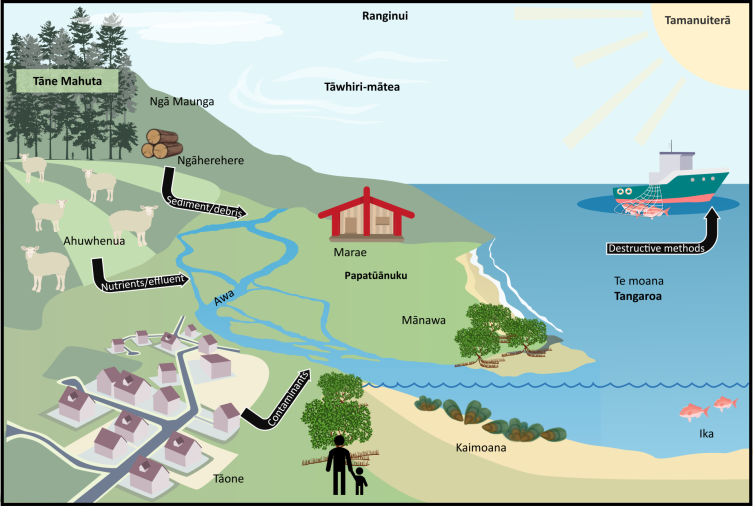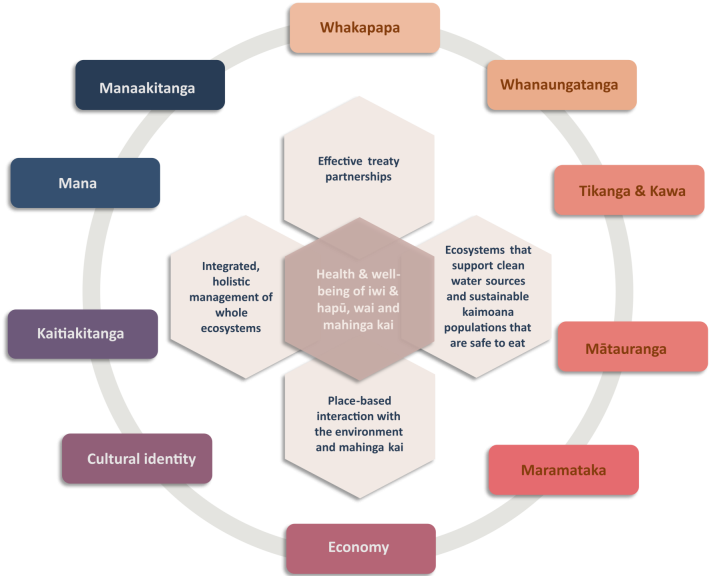Posted on 13 July 2023
Understanding cumulative effects from a te ao Māori perspective
- News
- 8 Minutes to read
What is meant by cumulative effects?
Stressors are pressures caused mostly by humans and associated activities that impact ecosystem components and/or processes. Stressors can include things like nutrient or sediment inputs from activities like farming or forestry. Cumulative effects is a term that recognises that while a single stressor from a particular activity may have small or minimal impact on the environment, multiple stressors may accumulate and interact to cause sudden and/or significant impacts (Thrush et al. 2014, Hewitt et al. 2016, Thrush et al. 2017). Cumulative effects research seeks to understand the impacts of multiple human activities to better inform ecosystem-based environmental and resource management.
How are cumulative effects described by iwi/hapū?
Iwi, hapū, and whānau have a holistic understanding of Te Ao Tūroa (the long-standing natural world). Every living thing, including people, is imbued with mauri (energy, life force) and is interconnected through whakapapa (genealogy). Cumulative effects can be thought of as an accumulation of all stressors and activities that impact Te Ao Tūroa – as experienced, determined and described by iwi and hapū.
Impacts on any part of the environment, for example through an activity, cause impacts on the adjacent components and mauri. For example, Rūnanganui o Ngāti Kahungunu (1992) explains that the “mauri of natural species are under threat through pollution, loss and degradation of habitat, and unsustainable exploitation” - a statement which takes into account multiple stressors that are interacting and impacting mauri.

Figure 1: Multiple activities on the land and sea produce multiple stressors which degrade mauri and impact Te Ao Tūroa at multiple scales. Atua domains are bolded.
Stressors experienced in one place (e.g., farming, forestry inland) can in turn, flow downstream via waterways, estuaries, harbours and ocean. This requires understanding and managing cumulative stressors across a range of organisational (e.g., iwi, hapū and whānau; local councils, regional councils and central government agencies), spatial (e.g., local, regional, national) and temporal scales (Fig. 1).
How are cumulative effects reflected in iwi and hapū planning?
Iwi and hapū environmental management plans lodged with Hawkes Bay Regional Council identify multiple stressors or cumulative effects and their impacts on cultural values, uses and opportunities (Table 1). For example:
- Compartmentalisation of environmental systems within legislation and across various Crown environmental management bodies has led to the degradation downstream, (for example) poor urban development land use intensification. This fails to account for ecosystem connectivity which additionally impacts iwi and hapū environment, social, and economic aspirations (e.g., Fig. 2).
- Poor land management strategies fail to take account for interconnectivity downstream, which has led to erosion, poor water quality from excess nutrients, sediments, point source discharges, heavy metals, and other contaminants (Table 1).

Figure 2: The cumulative effects of multiple stressors impact water quality, mahinga kai, and a variety of associated cultural principles, values, uses and practices. Adaptation of diagram from the “Iwi and hapū perspectives” section (Morrison et al 2023).
Table 1: Examples of how cumulative effects and the associated impacts (and solutions provided from mātauranga Māori) are reflected in iwi/hapū environmental management plans.
| Theme | Example |
| Environmental compartmentalisation |
“Tipuna Māori managed the environment as a totality. Activities designed for one area were coordinated with those of another area… The overriding principle of traditional plans and management is the sense of seeing the natural world in its entirety.” – Ngā kaitiaki o Te Rakato Marae Mahia Mai Tawhiti (no date). “Avoid compartmentalising the natural environment so that any impacts of mismanagement that affect the cultural health of the coastal environ (such as poor urban development, land use intensification and diversion of water) can be prioritised and remedied i.e., a whole catchment, ecosystem and habitat approach is utilised from the outset for planning, and for mitigation purposes.” – Te Taiwhenua o Heretaunga, 2015. |
| Poor land use and management practices | “We know through monitoring, testing, scientific reporting, and from living on the tūtaekurī awa that the mauri of the awa has degraded by the impact of land development… Pastoral grass cover, residential and industrial developments, horticulture cropping, and plantation forestry have replaced the previously flourishing native flora and fauna that blanketed Papatūānuku… has served to remove the blanket of native vegetation that bound and retained soil and sediments on the land, and that also captured, stored, utilised and filters the tears that fell from Ranginui…” – Ngā hapū o Tūtaekurī, 2015. |
| Unsustainable exploitation | “MAURI or life essence of natural species are under threat through pollution, loss and degradation of habitat, unsustainable exploitation… Mindless rape of native forests has destroyed habitats disrupted the food chain, and caused water pollution through erosion and nutrient run-off, all of which undermine the mauri of the affected species.” – Rūnanganui o Ngāti Kahungunu, 1992. |
| Water clarity/quality | “There are many contributing factors to the increasingly poor water quality in the Karamu Stream… The cumulative discharge of [such] chemicals when combined with sediment and nutrients can result in an overall degradation of fisheries and aquatic values.” – Ngāti Hori 2012. |
| Erosion and sedimentation | “The excess influx of sediment into our awa as a result of poor land management can cause damage to our awa and tributaries by blocking light that allows algae to grow; harming fish gills; filling up important habitats; supporting growth of toxic cyanobacteria; and by stopping fish from seeing well enough to move around or feed.” – Ngā Hapū o Tūtaekurī, 2015. |
| Point source discharges | “…some District and City Councils continue to pollute our rivers and coastal waters by allowing unacceptable levels of improperly treated wastes (effluent and sewage) to be discharged to them. The contamination of our coastal waters is highly objectionable and totally unacceptable culturally. The MAURI or life essence of the coastal ecosystem, particularly where our MAHINGA KAI – MĀTAITAI (food sources – fisheries) are concerned, is being progressively destroyed.” (Rūnanganui o Ngāti Kahungunu 1992). |
| Nutrients | “The Tūtaekurī awa has elevated nutrient seepage from surrounding catchment land use that contributes to elevated periphyton growth or thick green/brown slime mats that coat stable surfaces and suffocate the awa.” (Ngā Hapū o Tūtaekurī, 2015). |
| Heavy metals and other contaminants | “Ngāti Hori is concerned about the potential for stormwater run off from urban, roads and industrial areas that may contain contaminants such as heavy metals (arsenic, cadmium, chromium, copper, lead, mercury, nickel and zinc) and hydrocarbons… herbicides, insecticides, fungicides and other chemicals. There is also a long history of significant discharge of contaminants by industry.” – Ngāti Hori 2012. |
What is required to better manage cumulative effects issues?
Multi-benefit management actions
Iwi and hapū seek to mitigate the cumulative effects of various land use and management strategies towards best practice. Riparian planting, habitat restoration, and integrated, holistic management of the whole ecosystem/catchment are examples of improved practices expressed within Heretaunga iwi environmental management plans. These actions derive benefits for multiple values.
For example, the Waikato River Authority is a co-governance body established in 2010 as the custodian of the Vision and Strategy for the Waikato River (2008), and as the body responsible for overseeing the implementation of the clean-up of the river. The WRA have funded many projects such as the Maungatautari wetland restoration, which had the purpose of habitat revitalisation through native planting.
Ki uta ki tai as an integrated management approach
Using the underlying principles of integrated planning, i.e., ki uta ki tai coupled with assessing mauri (vitality; as a barometer of health) could provide holistic systems practice towards better outcomes for healthy wai and mahinga kai.
For example, the Whaka-Ora Healthy Harbour co-management plan for Te Whakaraupō (Lyttleton Harbour) was co-developed by iwi and hapū, local government, and industry. The purpose of the plan is the restoration of mahinga kai in Te Whakaraupō. The plan has goals and actions for each part of the catchment to ensure a holistically healthy systems for the benefit of future generations.
Spatially explicit cumulative effects models
Researchers in the Sustainable Seas National Science Challenge are developing models that assess the cumulative effects of multiple stressors in marine ecosystems, in a spatial planning context. Tool-based assessment of different management scenarios can inform the need for restoration or mitigation of activities to reverse ecological degradation. They can also inform managers of the capacity of the system to cope with new activities, and where activities could be located to minimise the likelihood of exceeding ecological thresholds. It is essential that these tools account for the values of iwi, hapū, whānau and rūnanga, to ensure all perspectives are understood, and that potential management actions support iwi, hapū and whānau environmental aspirations.
Further reading
- Hapū and iwi perceptions of cumulative effects
- Spatially-explicit cumulative effects tools
- Enabling kaitiakitanga and EBM
- Empowering Mana Moana
- Treaty-based marine governance & EBM
- Scale and EBM
---
This article was prepared by Mel Hayden for Spatially-explicit cumulative effects tools.
For further information, contact Melanie.Hayden@niwa.co.nz or project leader Carolyn Lundquist Carolyn.Lundquist@niwa.co.nz.